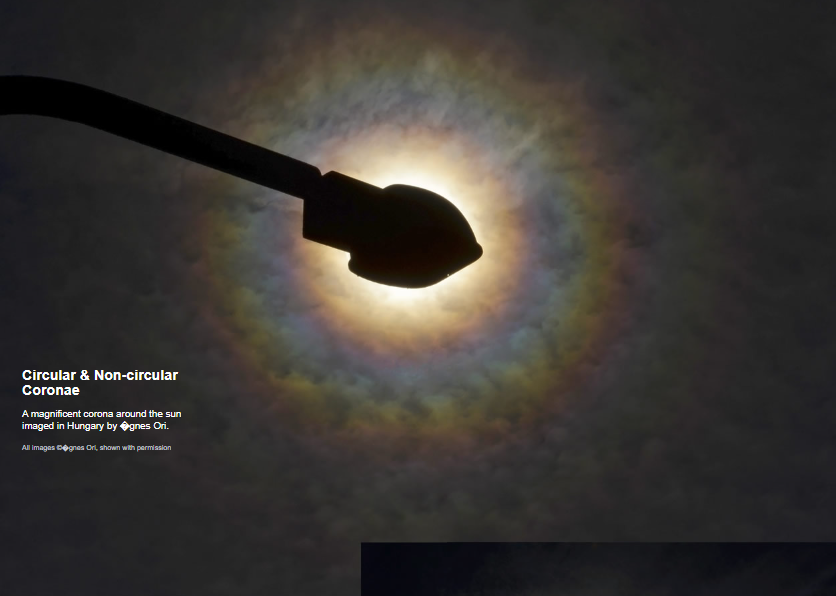Not so circular corona - OPOD
Not so Circular Corona - OPOD: Understanding Atmospheric Optics
When we gaze at the sky, we often witness stunning optical phenomena that capture our imagination. One such phenomenon is the corona, a magnificent halo of light encircling the sun or moon. While coronae are typically observed as circular rings, they can sometimes deviate from their perfectly round shape, creating intriguing and non-circular variations. In this article, we delve into the world of atmospheric optics to explore the factors that contribute to these captivating displays.
Coronae are formed through the diffraction of sunlight by countless tiny water droplets suspended in the atmosphere. Each droplet acts as an individual source of diffraction, scattering light in various directions. Unlike a diffraction grating, which operates collectively, the droplets in a corona act independently, producing a diffraction pattern unique to each droplet. This fundamental understanding helps us debunk the misconception that coronae are created by the collective action of droplets.
The size of the water droplets plays a crucial role in determining the appearance of a corona. Generally, smaller droplets result in larger angular sizes for the corona. When the droplet sizes vary systematically across a cloud, it leads to distortions in the corona's shape. In particular, the corona can become elongated or flattened depending on the distribution of droplet sizes. This deviation from a circular shape adds an extra layer of complexity and visual intrigue to the phenomenon.
In some cases, when the spatial arrangement of droplet sizes becomes less orderly, we observe a phenomenon known as cloud iridescence. This captivating display manifests as colors that appear chaotic and tend towards a disorganized pattern. The interplay between different droplet sizes and their scattering properties gives rise to this captivating intermingling of hues. Cloud iridescence offers a mesmerizing glimpse into the intricate nature of atmospheric optics.
To better understand the variations in coronae, let's examine a specific example. In an image captured in Hungary by the talented photographer Ágnes Ori, we can observe a corona that is almost circular. The central aureole, or inner region of the corona, transitions in color from straw-like tones to vibrant reds. Surrounding this central region is a ring that exhibits a mixture of colors, rather than a spectral range for each hue. Interestingly, this ring appears slightly flattened at the top, introducing a subtle departure from a perfectly circular shape.
It is important to note that atmospheric optics can be a complex field, and our understanding of these phenomena continues to evolve. The intricacies of droplet size distributions, their spatial arrangement, and the interplay of light scattering properties contribute to the diverse array of coronae we observe in the sky. Exploring these optical wonders allows us to appreciate the beauty and complexity of our atmosphere and deepens our understanding of the natural world around us.
In conclusion, coronae are captivating displays of light diffraction caused by sunlight interacting with tiny water droplets in the atmosphere. While most coronae appear as circular halos encircling the sun or moon, deviations from this shape can occur due to variations in droplet sizes and their spatial arrangement. These non-circular coronae add an extra layer of intrigue to the already mesmerizing world of atmospheric optics. By studying and appreciating these phenomena, we gain a deeper understanding of the complexities inherent in our natural environment.

Circular & Non-circular Coronae
A magnificent corona around the sun imaged in Hungary by �gnes Ori.
All images ©�gnes Ori, shown with permission

The top corona is almost circular. The central aureole tapers in colour from straws to reds. The surrounding ring is not spectral in its colour range for each hue is a colour mixture. The ring is slightly flattened at its top.
At right is a more pathological case.
Coronae are diffraction patterns in the sky produced by sunlight scattered from millions of small water droplets. The diffraction is from individual water droplets acting in isolation and definitely not collectively like a diffraction grating as claimed in this erroneous university website.
The smaller the droplets the greater the angular size of the corona. When the droplet diameter varies in a fairly orderly manner across a cloud the corona is distorted. At right the droplets in the lower right corner are the smallest.
A less orderly spatial arrangement of droplets sizes gives colours tending to the chaotic - cloud iridescence.

Note: this article has been automatically converted from the old site and may not appear as intended. You can find the original article here.
Reference Atmospheric Optics
If you use any of the definitions, information, or data presented on Atmospheric Optics, please copy the link or reference below to properly credit us as the reference source. Thank you!
-
<a href="https://atoptics.co.uk/blog/not-so-circular-corona-opod/">Not so circular corona - OPOD</a>
-
"Not so circular corona - OPOD". Atmospheric Optics. Accessed on November 26, 2024. https://atoptics.co.uk/blog/not-so-circular-corona-opod/.
-
"Not so circular corona - OPOD". Atmospheric Optics, https://atoptics.co.uk/blog/not-so-circular-corona-opod/. Accessed 26 November, 2024
-
Not so circular corona - OPOD. Atmospheric Optics. Retrieved from https://atoptics.co.uk/blog/not-so-circular-corona-opod/.